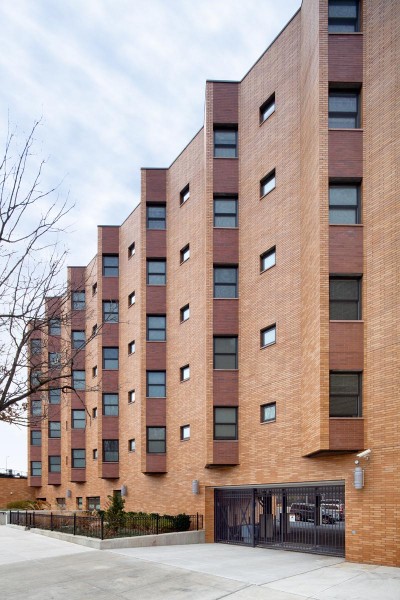“Prefab Apartment Buildings on the rise” according to Marketplace.org
Tags: adApt NYC, Affordable Housing, Green Building, High Quality Construction, Kanban Pull System, Lean manufacturing, Micro-unit apartment, Mini-apartments, modular building, Modular Construction, My Micro NY, Non Combustible Construction, offsite construction, Prefabrication, Supportive Housing, sustainable construction
Prefab apartment buildings on the rise
by Dan Bobkoff

The first floors of a modular apartment building are already in place behind the Barclays Center in Brooklyn.
A new apartment building called The Stack is about to open in the Inwood section of Manhattan. By design, it looks like a collection of staggered Lego blocks. On the inside, it’s like any other modern rental building in New York. It has a sleek, simple design.
What’s different is that these apartments were not built here in Manhattan, but almost entirely somewhere else.
“The paint, the lighting, the kitchen cabinets, the appliances, the bathroom tile, fixtures, mirror, all of that is done in the factory,” says The Stack’s architect, Tom Gluck, with the firm GLUCK+.
Gluck has been an architect for years, but this is the first time his firm has built what’s called a modular building.
Each apartment comes out of a factory from a company, like Capsys in the Brooklyn Navy Yard. It looks like an auto plant, complete with assembly line run on a track in the ground.
“Where we’re building pieces of building like you’d build a car in a factory. You get that repetition, that precision,” says Tom O’Hara, director of business development at Capsys.
On one end of the plant, a team is joining steel beams to make the skeleton of a new apartment. On the other end, a crew is putting the finishing touches on a unit. One guy is tiling the bathroom. You could cook in this kitchen. There’s even a thermostat on the wall already. The apartments are so close to finished that they look like you could move in immediately, if they weren’t sitting on a factory floor.

An apartment module nearing completion at Capsys. It will soon be trucked to the building site and hoisted into place. (Photo: Dan Bobkoff)
But soon, this entire apartment will be put on a flatbed, trucked to the Bronx, then hoisted on top of all the other modular apartments. When the building’s done, you won’t even know it was built this way.
There are many reasons proponents like O’Hara think modular construction is better: it’s built inside, away from weather and dirt. It’s faster because you can build the foundation and the building at the same time. There’s much less wasted material. And yet, while it’s popular in Europe, modular construction in the U.S. remains a rounding error, accounting for just a tiny percentage of new home and multifamily construction.
“I think a lot of people really have misconceptions about the modular business,” O’Hara says. “I think they feel somehow that there’s substandard construction in the factory.”
He says most people think modular means mobile homes or boring, blocky buildings. To him, it just means it’s built better.
“Why would I want my toaster built by a guy sitting on a bench with a ten snip banging things together. I want it out of a factory! Why shouldn’t the building come out of a factory?” O’Hara says.
Modular has been seen as the future before, and yet never caught on beyond certain sectors like college dorms and hotels.
But nearly everyone I talked to thinks this is the moment that changes.
“A lot of it truthfully has to do with this building that we’re standing in front of,” says Jim Garrison, an architect and professor at the Pratt Institute. We’re behind the new Barclays Center arena in Brooklyn, looking at what’ll soon be the tallest modular building: 32 stories of apartments.
It’s funded by a big name developer. Garrison says it’s the biggest example that modular is possible, practical, and not necessarily cookie cutter.
“We now have opportunities to build very interesting buildings using these systems. And, people are listening to the benefits that come with it,” Garrison says.
That’s not to say modular doesn’t have downsides. Because it’s made of boxes, you end up with walls against walls, taking up valuable square footage in the building. Designers have to decide everything on the front end. But more developers are attracted to modular’s faster, and sometimes cheaper construction. And, with new projects in the works, maybe this time is different.






